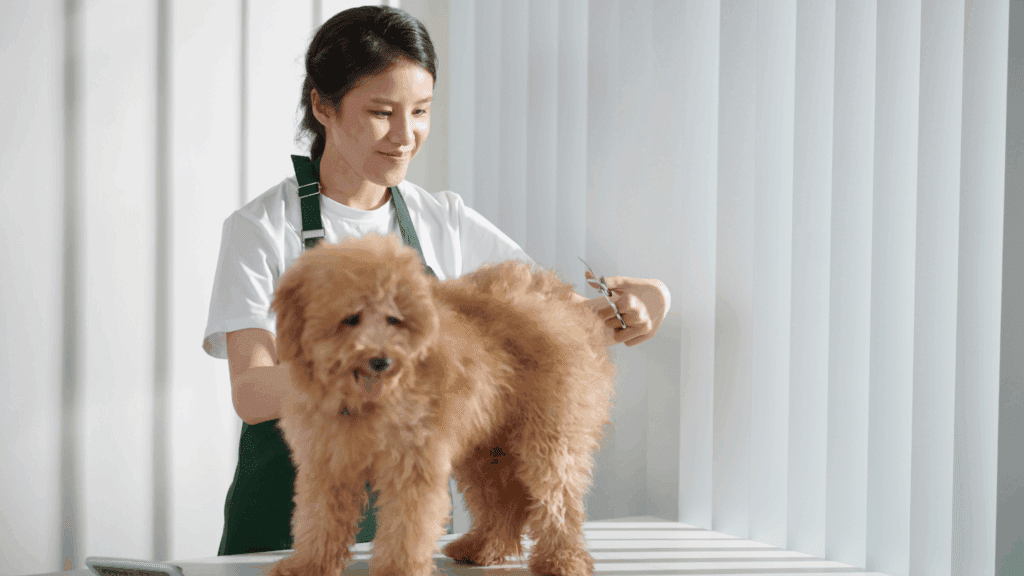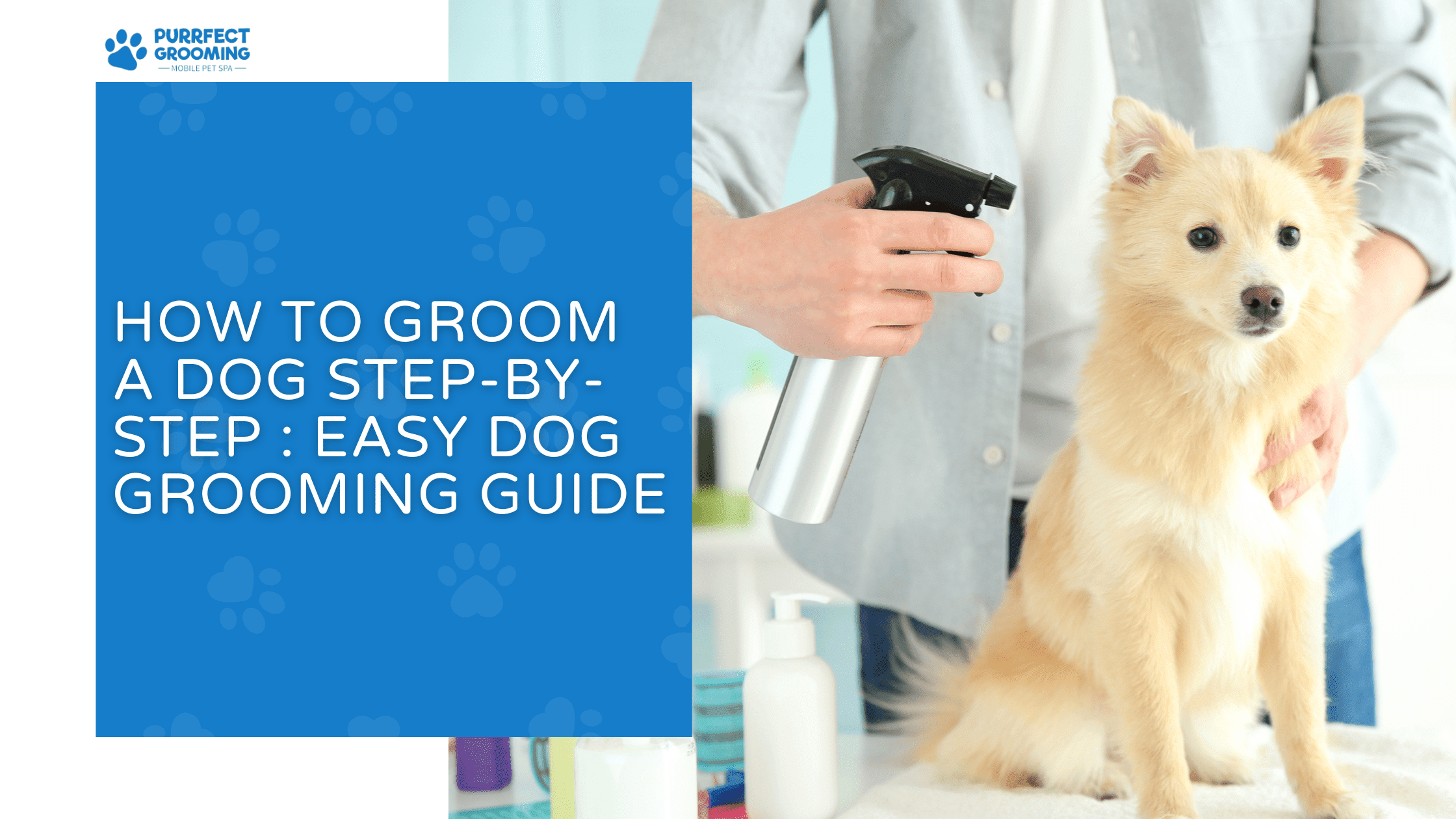How to Groom a Dog Step-by-Step : Easy Dog Grooming Guide
Dogs are more than just pets, they’re beloved members of our families. And just like any family member, they need proper care and attention to thrive. One essential aspect of dog care is grooming. Regular grooming not only keeps your dog looking their best but also contributes to their overall health and well-being. In this comprehensive guide, we’ll take you through the step-by-step process of grooming your dog, ensuring that they stay clean, comfortable, and happy.
Grooming your dog isn’t just about keeping them looking cute—it’s an essential part of their overall health and happiness. From brushing out tangles to trimming nails, a consistent grooming routine helps you monitor your pet’s skin, coat, ears, and paws, giving you a chance to spot issues early. For instance, regular grooming has been shown to reduce the risk of skin problems and allow early detection of lumps or infections. In this step-by-step guide, we’ll walk you through the best practices and tools to make grooming a stress-free, bonding experience for you and your furry friend.

Step 1: Gather Your Grooming Supplies
Before you begin, it’s essential to have all the necessary tools and supplies ready. Having everything on hand will make the grooming process smoother and more efficient. Here’s a list of grooming supplies you’ll need:
- Dog Shampoo: Choose a high-quality dog shampoo that suits your dog’s coat type and any specific needs (e.g., hypoallergenic, medicated, or flea control).
- Dog Conditioner: Optional but recommended, especially for dogs with long or thick coats.
- Brushes and Combs: Select the appropriate brushes and combs for your dog’s coat type (slicker brush, bristle brush, pin brush, comb, and de-shedding tool).
- Nail Clippers or Grinder: Use clippers or a grinder designed for dogs, as well as styptic powder to stop bleeding in case you cut the nail too short.
- Ear Cleaner: A gentle ear cleaner for routine ear care.
- Cotton Balls and Q-Tips: For cleaning ears and applying ear cleaner.
- Towels: Have several clean towels on hand for drying your dog.
- Blow Dryer: A pet-specific dryer, if possible, to speed up drying time.
- Toothbrush and Dog Toothpaste: For dental hygiene.
- Treats: Reward your dog for good behavior during grooming.
Step 2: Prepare Your Dog
Before diving into the grooming process, ensure your dog is comfortable and relaxed. Here are some tips to prepare your dog:
- Exercise: Take your dog for a short walk or playtime to release any excess energy. A tired dog is often more cooperative during grooming.
- Brushing: Start by brushing your dog’s coat to remove any tangles or mats. This not only makes the grooming process easier but also helps distribute natural oils for a healthier coat.
- Positive Association: Make grooming a positive experience by offering treats and praise throughout the process. Let your dog sniff and explore the grooming tools to reduce anxiety.
Step 3: Bathing Your Dog
Bathing your dog is a crucial part of the grooming routine. Follow these steps for a successful bath:
- Prepare the Bathing Area: Use a bathtub or a large basin with a non-slip mat. Make sure the room is warm, and close any doors or windows.
- Brush Beforehand: Brush your dog’s coat again before the bath to remove loose hair and mats.
- Water Temperature: Fill the tub with lukewarm water. Make sure it’s not too hot or too cold. Test it with your wrist to ensure it’s comfortable.
- Wet Your Dog: Gently wet your dog’s coat, avoiding their ears and eyes. Use a handheld sprayer or a cup to pour water over them.
- Shampoo: Apply a small amount of dog shampoo and lather it over your dog’s entire body, including their legs, belly, and tail. Be extra gentle around the face and ears.
- Rinse Thoroughly: Rinse your dog thoroughly to remove all traces of shampoo. Leftover soap can cause skin irritation.
- Conditioner (Optional): If your dog’s coat is prone to tangles, apply conditioner, and rinse it out thoroughly.
Step 4: Drying Your Dog
After the bath, it’s time to dry your dog:
- Towel Dry: Gently pat your dog dry with a clean towel. Avoid vigorous rubbing, as it can tangle the coat.
- Use a Dog Dryer: If you have a dog-specific dryer, use it on the lowest heat setting to dry your dog’s coat. Keep the dryer at a safe distance to avoid overheating.
- Brush During Drying: As you dry your dog, use a brush to keep their coat from matting. Pay special attention to areas like the belly, armpits, and behind the ears.
Step 5: Brushing and Combining
Regular brushing and combing are essential for keeping your dog’s coat in top condition. Here’s how to do it:
- Brushing: Brush your dog’s coat again, starting with a slicker brush or pin brush for removing tangles and loose hair. Follow this with a bristle brush for a smooth finish.
- Combing: Use a comb to carefully go through your dog’s coat to check for any remaining tangles or mats. Pay attention to sensitive areas like under the legs and around the ears.
Step 6: Nail Care
Trimming your dog’s nails is crucial to prevent overgrowth and discomfort. Here’s how to do it safely:
- Use the Right Tools: Make sure you have the appropriate nail clippers or grinder for your dog’s size and breed.
- Be Cautious: Trim the nails slowly and in small increments to avoid cutting the quick (the sensitive part of the nail). If you’re unsure, consult a professional groomer or veterinarian.
- Styptic Powder: Have styptic powder on hand in case you accidentally cut the quick. Apply it to stop any bleeding immediately.
Step 7: Ear Cleaning
Cleaning your dog’s ears helps prevent infections and discomfort:
- Inspect the Ears: Check your dog’s ears for dirt, wax buildup, or signs of infection.
- Clean Gently: Use a cotton ball or Q-tip moistened with an ear cleaner specifically designed for dogs. Clean only the visible parts of the ear and avoid inserting anything deep into the ear canal.
Step 8: Dental Care
Maintaining your dog’s dental health is vital for their overall well-being:
- Brushing Teeth: Use a dog toothbrush and toothpaste to brush your dog’s teeth regularly. Start slowly to get your dog used to the process.
- Dental Chews: Provide dental chews or toys designed to promote healthy teeth and gums.
Step 9: Final Touches
After completing the main grooming steps, take a moment for these final touches:
- Trim Facial Hair: If your dog has long facial hair, trim it carefully to keep it out of their eyes.
- Check Anal Glands: If your dog is prone to anal gland issues, consult your vet or groomer for guidance on how to express them safely.
- Reward and Praise: Reward your dog with treats, praise, and plenty of love for their patience and good behavior throughout the grooming process.
Step 10: Regular Maintenance
Grooming is an ongoing process. Maintain a regular grooming schedule based on your dog’s breed and coat type. Some dogs may need grooming every few weeks, while others can go longer between sessions.
Conclusion:
In conclusion, grooming your dog is an essential part of responsible pet ownership. It not only keeps your dog looking their best but also contributes to their overall health and comfort. By following these step-by-step instructions and establishing a grooming routine, you can ensure that your furry friend stays happy, healthy, and well-groomed for years to come.
Grooming your dog is a fundamental aspect of responsible pet care. It’s not just about aesthetics but also about ensuring your furry friend’s health and comfort. By following the step-by-step guide provided, you can make grooming a positive experience for both you and your dog.
Remember that grooming requirements vary from one dog to another, so it’s crucial to understand your dog’s specific needs based on their breed and coat type. Additionally, regular grooming sessions provide an excellent opportunity to bond with your pet and monitor their overall well-being.
Whether you choose to groom your dog at home or seek the expertise of a professional groomer, the most important thing is to prioritize your dog’s welfare. With proper care and attention, your dog will not only look fantastic but also feel fantastic, leading to a happy and healthy life together.
FAQs
1. How often should I groom my dog?
The frequency of grooming depends on your dog’s breed and coat type. Some dogs require grooming every 4-6 weeks, while others may only need it every few months. Regular brushing and maintenance can help you determine when grooming is necessary.
2. Can I use human shampoo on my dog?
No, it’s not recommended to use human shampoo on dogs. Human shampoos can disrupt the pH balance of a dog’s skin and may contain ingredients that are harmful to them. Always use a dog-specific shampoo that suits your dog’s needs.
3. How do I prevent my dog from becoming anxious during grooming?
To prevent anxiety, start grooming your dog from a young age to get them used to the process. Use positive reinforcement, treats, and praise to reward good behavior. Gradually increase the grooming time to build tolerance and trust.
4. Should I groom my dog at home or take them to a professional groomer?
The choice between grooming at home and using a professional groomer depends on your dog’s breed, coat type, and your comfort level with grooming tasks. Some dogs with complex grooming needs may benefit from professional grooming, while others can be groomed at home with the right tools and knowledge.
5. What should I do if I accidentally cut my dog’s nail too short?
If you cut your dog’s nail too short and it starts bleeding, don’t panic. Apply styptic powder or cornstarch to the bleeding nail to stop the bleeding. It’s essential to remain calm to keep your dog calm as well. If bleeding persists or you’re unsure, consult your veterinarian.
